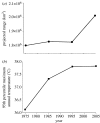The cane toad's (Chaunus [Bufo] marinus) increasing ability to invade Australia is revealed by a dynamically updated range model
- PMID: 17389221
- PMCID: PMC2176198
- DOI: 10.1098/rspb.2007.0114
The cane toad's (Chaunus [Bufo] marinus) increasing ability to invade Australia is revealed by a dynamically updated range model
Abstract
Invasive species threaten biological diversity throughout the world. Understanding the dynamics of their spread is critical to mitigating this threat. In Australia, efforts are underway to control the invasive cane toad (Chaunus [Bufo] marinus). Range models based on their native bioclimatic envelope suggest that the cane toad is nearing the end of its invasion phase. However, such models assume a conserved niche between native and invaded regions and the absence of evolution to novel habitats. Here, we develop a dynamically updated statistical model to predict the growing extent of cane toad range based on their current distribution in Australia. Results demonstrate that Australian cane toads may already have the ability to spread across an area that almost doubles their current range and that triples projections based on their native distribution. Most of the expansion in suitable habitat area has occurred in the last decade and in regions characterized by high temperatures. Increasing use of extreme habitats may indicate that novel ecological conditions have facilitated a broader realized niche or that toad populations at the invasion front have evolved greater tolerance to extreme abiotic conditions. Rapid evolution to novel habitats combined with ecological release from native enemies may explain why some species become highly successful global invaders. Predicting species ranges following invasion or climate change may often require dynamically updated range models that incorporate a broader realization of niches in the absence of natural enemies and evolution in response to novel habitats.
Figures



References
-
- Brown G.P, Phillips B.L, Webb J.K, Shine R. Toad on the road: use of roads as dispersal corridors by cane toads (Bufo marinus) at an invasion front in tropical Australia. Biol. Conserv. 2006;133:88–94. doi:10.1016/j.biocon.2006.05.020 - DOI
-
- Burnham K.P, Anderson D.R. Springer; New York, NY: 2002. Model selection and multimodel inference: a practical information–theoretic approach.
-
- Butin E, Porter A.H, Elkinton J. Adaptation during biological invasions and the case of Adelges tsugae. Evol. Ecol. Res. 2005;7:887–900.
-
- Case T.J, Taper M.L. Interspecific competition, environmental gradients, gene flow, and the coevolution of species' borders. Am. Nat. 2000;155:583–605. doi:10.1086/303351 - DOI - PubMed
-
- Colautti R.I, Ricciardi A, Grigorovich I.A, MacIsaac H.J. Is invasion success explained by the enemy release hypothesis. Ecol. Lett. 2004;7:721–733. doi:10.1111/j.1461-0248.2004.00616.x - DOI
Publication types
MeSH terms
LinkOut - more resources
Full Text Sources
Other Literature Sources

